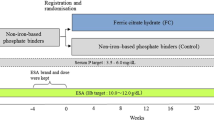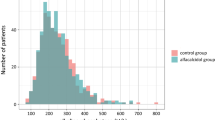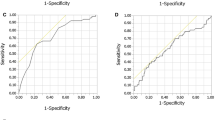Abstract
In conjunction with rehydration, the bisphosphonates are the treatment of choice for hypercalcaemia of malignancy. Single infusions of either pamidronate or clodronate are usually effective, but a direct comparison of the two agents given at the highest doses commonly used has not been performed. Forty-one patients (15 breast, 12 squamous carcinomas, four lymphomas, four bladder, two prostate and four others) with hypercalcaemia of malignancy (corrected serum calcium > 2.7 mmol l-1) persisting after 48 h of saline rehydration were randomly allocated to receive a 4 h intravenous (i.v.) infusion of either pamidronate 90 mg or clodronate 1500 mg. No other systemic anti-cancer treatment was prescribed. There were no significant differences in the post-hydration serum calcium values (mean 3.17 mmol l-1 for pamidronate and 3.06 mmol l-1 for clodronate), tumour type or frequency of bone metastases between the two treatments. One patient on each treatment died within 2 days and was not assessable for response. A total of 19/19 (100%) patients achieved normocalcaemia following pamidronate and 16/20 (80%) with clodronate. The median time to achieve normocalcaemia was 4 days (range 2-14) for pamidronate and 3 days (range 2-6) with clodronate. The median duration of normocalcaemia was 28 days (range 10-28+ days) after pamidronate and 14 days after clodronate (range 7-21 days) (P < 0.01). Two patients who failed to respond to clodronate were successfully treated with pamidronate and achieved normocalcaemia for 14 and > 28 days respectively. Two patients experienced fever after pamidronate but no significant toxicity was observed with either treatment. We conclude that both agents are effective in the management of hypercalcaemia of malignancy. At the doses studied, the effects of pamidronate are more complete and longer lasting than those of clodronate.
This is a preview of subscription content, access via your institution
Access options
Subscribe to this journal
Receive 24 print issues and online access
$259.00 per year
only $10.79 per issue
Buy this article
- Purchase on Springer Link
- Instant access to full article PDF
Prices may be subject to local taxes which are calculated during checkout
Similar content being viewed by others
Author information
Authors and Affiliations
Rights and permissions
About this article
Cite this article
Purohit, O., Radstone, C., Anthony, C. et al. A randomised double-blind comparison of intravenous pamidronate and clodronate in the hypercalcaemia of malignancy. Br J Cancer 72, 1289–1293 (1995). https://doi.org/10.1038/bjc.1995.502
Issue Date:
DOI: https://doi.org/10.1038/bjc.1995.502
This article is cited by
-
A phase II, multicentre trial evaluating the efficacy of de-escalated bisphosphonate therapy in metastatic breast cancer patients at low-risk of skeletal-related events
Breast Cancer Research and Treatment (2014)
-
Cellular Players in Breast Cancer Bone Metastases
Clinical Reviews in Bone and Mineral Metabolism (2013)
-
L’hypercalcémie associée au cancer
Journal Africain du Cancer / African Journal of Cancer (2012)
-
Médicaments de l’ostéolyse tumorale
Oncologie (2009)



